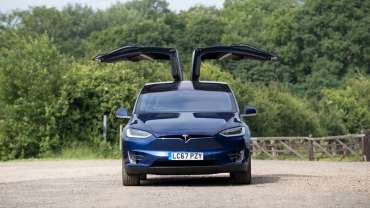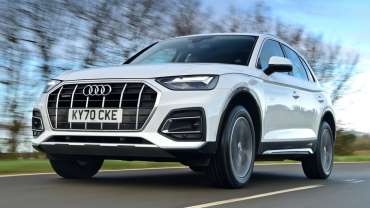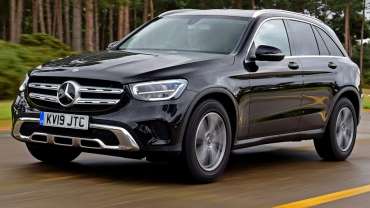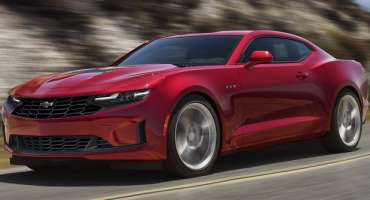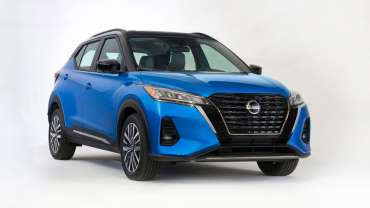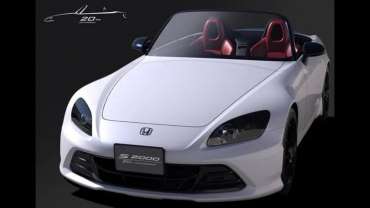
Worldcarblog.com
Tesla Model X review: clean, clinical, conspicuous
The only thing more volatile than a Tesla fanboy's mood swings is the company's share price. But away from Twitter and Instagram devotees, the Model X cuts an imposing, whale-shaped hole into the electric car chasm. We'll leave it to you to make puns about it serving a porpoise...
Falcon doors (more on those later), an iPad-like cockpit screen, fart sound effects, and an unholy 0-62mph time of 2.6 seconds for the fastest model help the Tesla stand out from the crowd. But the crowd is circling, and growing.
In case you've missed them, Audi, Mercedes, and Jaguar all have electric SUVs now in the shapes of the i-Pace, EQC, and Audi e-Tron. While BMW's effort, the iX3, is now beginning to trickle into showrooms.
Sure, they're all more compact than the Model X - closer in size to the forthcoming Model Y in fact - but in these early days of manufacturers fleshing-out their electric ranges it's fine to combine the choices together.
Best electric cars: the CAR guide
With that pressure mounting, is the Model X still the car to go for if you want something that's flashy, huge, and green?
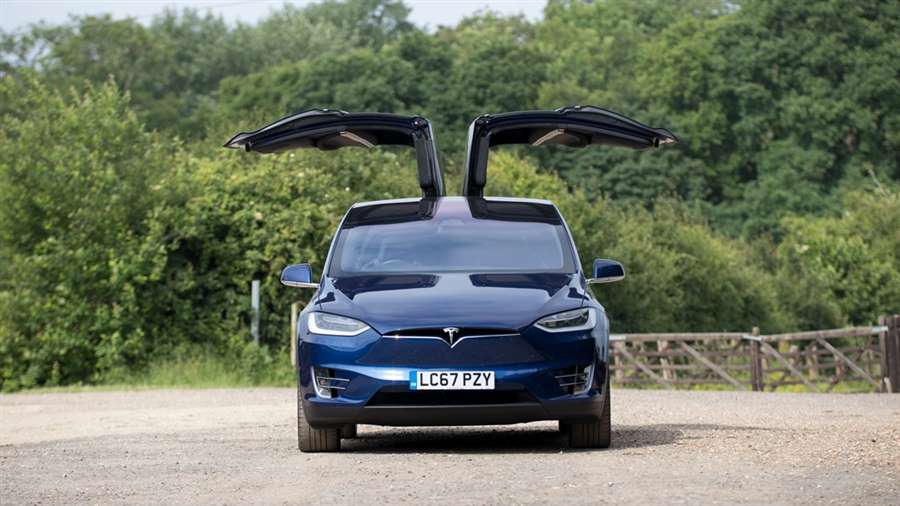
More like Tesla Model XXL...
Tesla has matured since the days of the original Roadster, and now Elon Musk’s EV company has a distinct design language. Featuring a minimal grille with no air inlets – a benefit of not having to cool down the byproducts of combustion in a traditional engine – the Model X looks like the updated Model S – but unlike anything else on the road.
The Tesla Model X is just as distinctive from the reverse angle, but those clean lines betray just how huge it is. And it really is vast, so you can get it in five-, seven- or six-seat configurations.
Those Falcon Wing doors
Tesla’s Falcon Wing doors set the Model X apart from the Model S, as well as every other vehicle – and they get their own section in this review. While they appear to be a gimmick – and often feel like one – they’re sometimes genuinely useful.
To begin with, you can’t help but feel they’re made for early-adopters to flaunt at Superchargers like peacocks. The whole process seems to take a while, and the doors don’t always unfurl in a smooth or uniform way, giving the impression they’re rather flimsy.
That’s a shame, because there were times when the doors really came in handy. When parked close to other cars, for instance, they allow multiple passengers to hop in and out, where other doors would require a squeeze. Tesla says they’re invaluable for elderly passengers too, and you can see why.
But the doors can also be a nuisance, and there were times we’d try to avoid using them. Forgotten a bag in the back? Can’t stretch round and get it from the driver’s seat? Nope. Moments later, seconds later, you’ve got your bag, but onlookers think you’re trying to show off.
Are they cool? Debatable. Are they useful? Sometimes. Perhaps a Tesla Model X with one conventional door and one Falcon-wing would be a suitable halfway-house - although this presents problems for building cars for right- and left-hand drive markets.
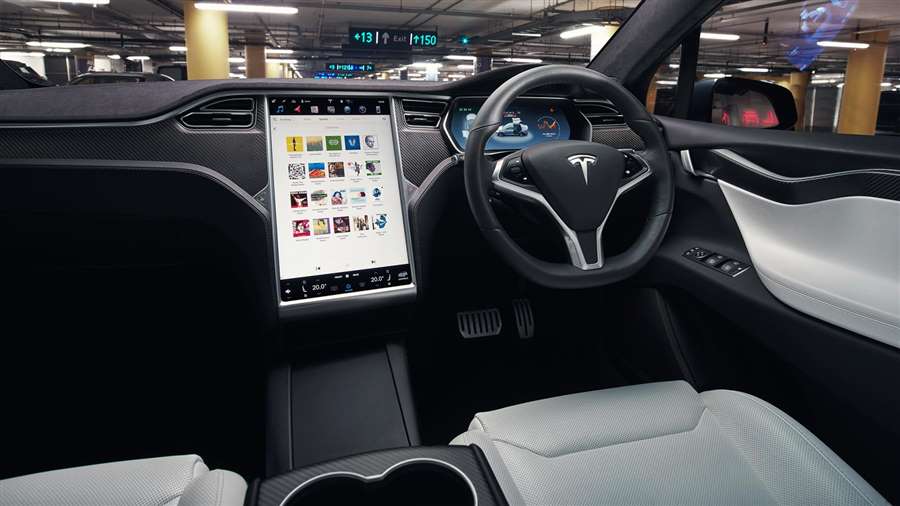
Is the Tesla Model X practical?
Whatever you think of the doors, they’re part of the Model X’s focus on practicality, and that design ethos is evident inside the car, too. Three seating configurations are available, and seats can be electrically folded and moved like parlour tricks: lightly press a hidden button and headrests fold down, for example.
With the rear two seats folded away the boot isn’t small, and if you’re still not happy, there’s always the froot (front boot to those allergic to naff portmanteaux). However, all that empty space doesn't always translate to spaciousness; when specified with two seats in the middle row, they're positioned close to the rear doors with an overly large gap between them, rather than adding elbow room for the outer edge. Even the front seats offer a more balanced amount of elbow room on either side.
Seven-seat fully-electric SUVs are few and far between. The e-Tron, iX3, i-Pace and EQC are all strictly five-seaters. The Model S can do you seven-seats, while if you're really not bothered by SUVnes, there are always the Mercedes EQV and Nissan e-NV200 car-derived vans.
What’s it like to drive?
Imagine a Model S with more height and weight, and you’re pretty much there. Just like the saloon, the Model X offers a relatively firm ride and swift linear acceleration, but only really reminds you of its 2.3 tonnes when you brake or turn. The performance is fun on slip roads and genuinely useful on the motorway, but don’t think this is a Stelvio Quadrifoglio rival. It just happens to be whisper-quiet and quick.
If acceleration is too fast for you, putting the car in Chill mode will make the performance a little more laidback - and handily extend the battery range too.
Like its siblings, the Model X’s steering is more of a switch than a precise instrument. Changing it to a sportier mode certainly helps, but not much. It may be a family car, but it’s an area where Tesla will need to improve on to compete with the work of more experienced chassis engineers if it wants to appeal to drivers who well, enjoy driving.
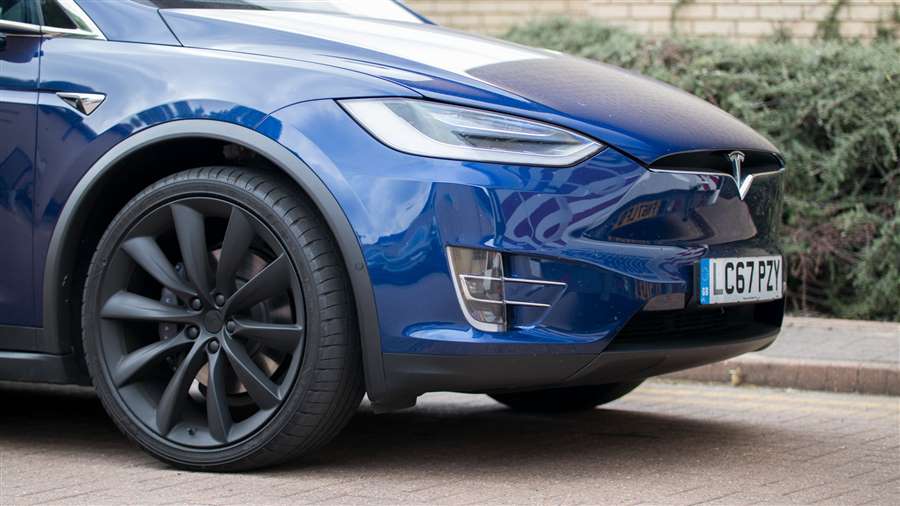
Of course, Tesla's ultimate ambition is that you won’t be driving in the traditional sense all the time anyway. Our Model X was fitted with Tesla Autopilot, and it remains one of the best driving assistance packages on the market today. Once the system decides the road is suitable, Autopilot is engaged with two pulls of the dedicated stalk, and that’s pretty much it. Just twist the stalk to pick the distance between you and the car ahead.
Traffic jams, motorway lane changes and sliproads are handled swiftly and smoothly, though, perhaps reassuringly, it errs on the side of aggressively cautious when confronted with cars that wander around their lanes too much. Outside of the motorway network, the usual parking assistance and ability to just let it creep at urban speeds following the car in front is enough to lower the heart rate somewhat.
European legislation currently limits the level of autonomous driving allowed, more than the technology in the car. In America, Autopilot can be seen handling long drives, albeit with the driver present - in Britain, the Tesla's Autopilot is suitable for taking the strain out of long motorway drives but still requires a constant hand on the wheel, and clear input to show someone other than the computer is paying attention. This also limits Tesla's ability to self-park and summon in the UK - for now.
Even when Autopilot isn’t engaged, the Tesla continually advises you on your proximity to other vehicles, and will even identify lorries and motorcycles in your path. That small detail helps to build an element of trust between you and the car, and means when you do use Autopilot, you’re aware the Tesla has it covered.
But it’s not without faults. Lane changes are a little awkward when using Autopilot (nudge the indicator, and it'll swap lanes for you), as they seem to take an age, and often result in you doing the steering yourself. What’s more, road users with loose lane-discipline can also scare the Tesla into dramatically slowing down.
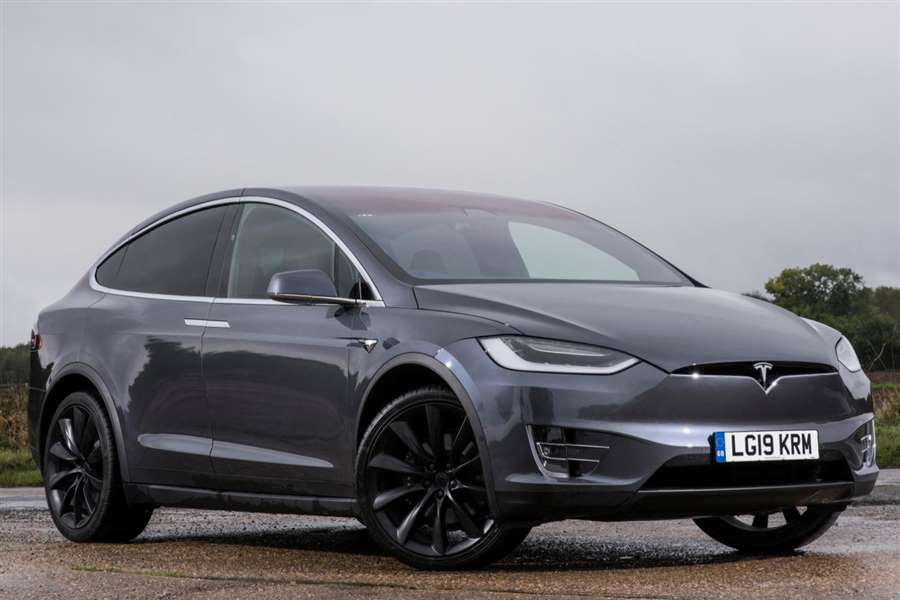
But will I be able to charge my Tesla Model X?
The charging experience will largely be determined by where you are in the country and what you do with your Model X. The Tesla Supercharger network is growing and using one is how all electric car charging should be; plug it in and within seconds you can see the range increasing as it gets a full 120kW up its socket. Filling from empty takes less than one hour - and most users will typically be topping up rather than 'brimming' their batteries.
While you can get chargers installed in your home, we were able to complete trips between Peterborough and London – along with local errands – by just using the Superchargers at Bishops Stortford on the way up or down. Throw in the ability to charge at home and at work, and unless you're venturing very far, and into an area of lower charging coverage, range is hardly worth thinking about. It just works.
When you do have to charge, though, the experience is painless. After plugging in, you can either hang around and follow the charging progress on a smartphone app, or just wait in the car – though fan noise during charging can get quite loud.
One tip though. If you’re able, it’s best to charge to full capacity even if you don’t need to. That way, when you arrive at your destination, there’s still juice to make it to another charger on the return leg.
What else do I need to know?
Adding in the six- or seven-seat options costs extra but is definitely worthwhile, otherwise you might as well stick with the more conventional Model S.
And the Tesla Model X UK price? Starting at £87,980 for the long-range model or £102,980 for the Performance - with 'ludicrous mode' and a slightly reduced WLTP range - it's far from an enabling technology that will change the world; for that, you'll need the smaller, more conventional Model 3.
Tesla Model X: verdict
Four years on from launch, the Tesla Model X isn’t the leap ahead it used to be, but it’s still a quirky, intuitive SUV – and one that’d probably suit some families well. The Model X is still disruptive, and from the sci-fi panoramic windscreen to doors that open for you, the Tesla still gives you some things that other cars just don’t have.
At the time of writing, the Tesla Model X wins by default in this sector. But the Jaguar i-Pace, Mercedes EQC and Audi e-Tron are all close. What these cars lack in range, they make up for in dynamics and build quality.
Source: carmagazine.co.uk
How to Best Prepare for A Winter Driving Test
The pandemic has seen both learner drivers and instructors affected well into the end of the year 2020, as the weather turns colder and the nights draw in. But the good news is that in all tiers in the UK, lessons and tests can continue to take place.
If you’ve been having driving lessons in Birmingham and are expecting to take your test in a West Midlands test centre, then you are likely to have been waiting several weeks to take your final driving test. And if you are still waiting for that special date, you could see your test taken place in the winter months of January and February. So, if you want to make the best use of your time, here are some tops tips for preparing to take a driving test in winter.
Stopping distance, thinking time and braking distance
You may have come across this topic in your theory test, but it’s worth reminding yourself of the difference between stopping, thinking and braking distance, and the various factors that can affect these whilst driving.
The thinking time is the time it takes you to react to the situation when you are driving, with the thinking distance being the amount your car has travelled between reacting to the hazard and pressing the brake pedal (or reacting in the correct manner). It is impossible to apply the brakes at the same time as a car in front of you, so to work out a stopping distance you have to take this thinking time into consideration.
The braking distance is the time it takes your vehicle to stop from the moment you hit the brake pedal, and can be affected by road conditions and conditions of the vehicle – although it is unlikely to be the case for your driving test as the car will be regularly checked for faults, poor tyres and brakes etc.
Stopping distance is the total time it takes for your vehicle to stop from the moment you see a hazard or brake lights ahead of you. The stopping distance can be calculated by adding the thinking time/distance and the braking distance, and changes depending on the speed of the car and the type of weather:
- When driving in rainy and wet conditions, the Highway Code advises the stopping distance to be at least double the distance compared to a dry surface because the road will be more slippery and there can be reduced visibility in heavy rain.
- For icy and snowy conditions, the Highway Code states that your braking distance can be ten times higher than that on a standard road. This means the stopping distance will also be increased. Again, consider the thinking distance due to poor visibility.
Use your time indoors wisely
With the winter weather keeping you inside, and the likely lengthy waiting time you have until you take your driving test, you can use this time to prepare even more for that day.
One of the things you can do at home, is to improve your reflexes and reaction times, as these skills can help you when dealing with other vehicles on the road and any hazards that can appear along the way. It’s been scientifically proven that playing video games, particularly action-themed games, are beneficial as this helps you to make quick decisions in tense situations, or when there’s lot happening at once. Video games can also make your reaction time better as they can make you more aware of your surroundings. All of which are transferable skills for your driving test, as the more alert you are to your surroundings, the less likely you are to make a mistake or have an accident.
You can also use this time stuck indoors to hit the books and revisit your theory test revision. It can only be a benefit to remind yourself of the Highway Code and road signs before getting in a car with an examiner. After all, it is a legal requirement to abide by the rules of the Highway Code, but it can also make you feel more confident and relaxed about taking your test. It’s also a great way to keep up to date with the DVLA standards of driving, as it is possible that there will be some changes by the time you take your driving test. It all helps towards preparing for when you get back behind that wheel again.
Source: automotiveblog.co.uk
New Audi Q5 40 TDI 2021 review
The revised Audi Q5 40 TDI SUV delivers plenty of tech and surprising value
Verdict
The revised Audi Q5 offers useful updates when it comes to efficiency, performance and on-board technology. It still looks stylish inside and out, it’s well built and although it’s a bit dull to drive, it’s comfortable, refined and practical. The real surprise here in the most basic Sport trim is that it delivers impressive value for money, with a generous amount of standard kit.
Think premium SUV, and the chances are that you’ll think of the Audi Q5. From the way it drives to the way it’s built and how it looks, the Q5 has always been a solid choice. But the pace of development in this class is fast, so there’s a new version of the German firm’s mid-size SUV.
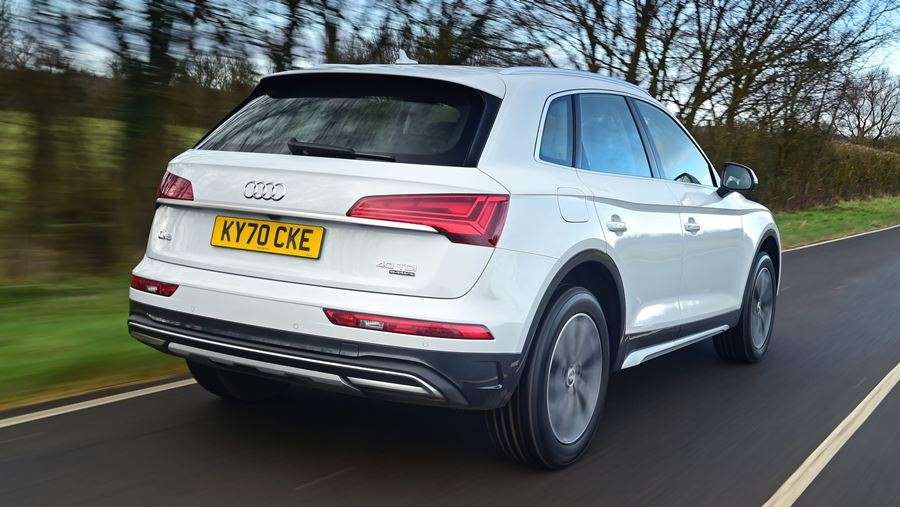
The updates focus heavily on technology to keep pace with newer models in the class, as well as revisions to the 40 TDI diesel model we’re testing here, making it cleaner and more powerful, thanks in part to mild-hybrid electrification.
The level of standard kit has taken a step forward as well, so even this entry-level Sport model could offer everything you’ll realistically need, even if on its standard 18-inch wheels it doesn’t look quite as sharp or as aggressive as the sportier S line trim that sits above it. Sport still receives new LED headlights and the same overall visual updates, with a larger, more pronounced grille that features some silver vertical bars to help it stand out. There’s a different design for the front bumper, too, while at the rear the changes are less significant. It’s a subtle but effective facelift overall.
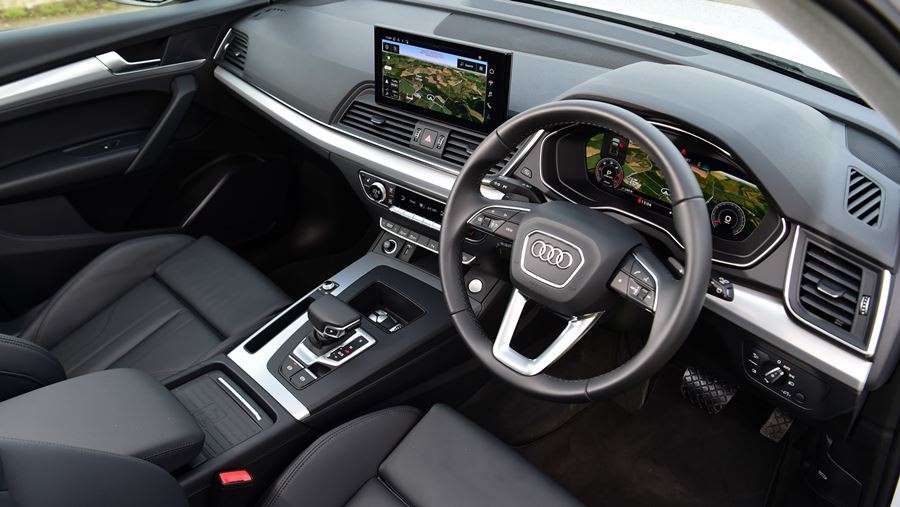
The SUV has also received the same treatment inside as its A4 and A5 siblings, with a new 10.1-inch central touchscreen as part of the MMI Nav Plus system that replaces the older scroll wheel on the transmission tunnel. There’s now a slightly awkward, rather shallow storage tray in its place, but build and material quality is still as good as you’d expect from an Audi, while the updated tech is sound. It works with the level of speed and response to your inputs you’d expect from a premium model, while there are lots of features, too.
There’s no real reason not to get on with the native system because the menus are fairly logical and easy to navigate, plus the graphics are great and the screen is well positioned in your eyeline (if maybe just a tiny bit too far away from the driver). But Apple CarPlay and Android Auto are also fitted as standard, so you can plug in your smartphone instead if you want.
On top of this you also get heated sports seats in Audi’s twin leather upholstery, three-zone climate control, cruise control, front and rear parking sensors with a reversing camera, and autonomous emergency braking with collision warning and pedestrian detection.
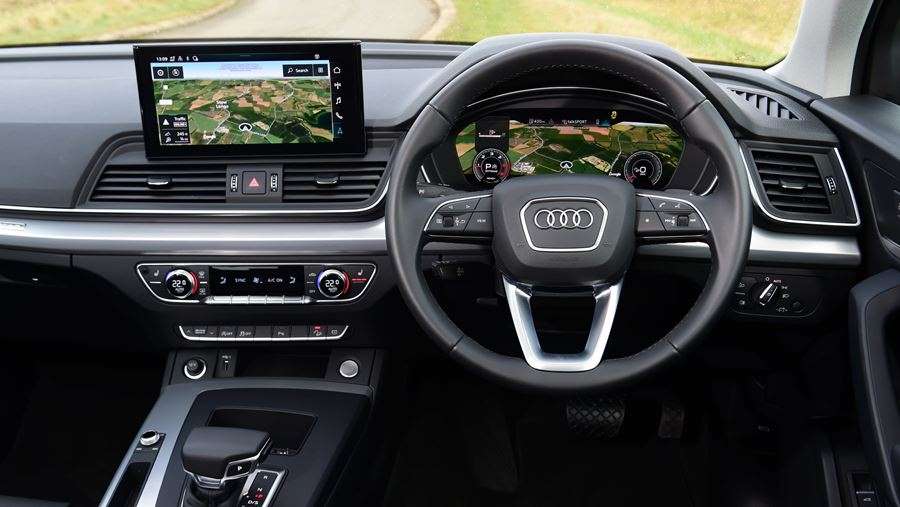
The Q5 inherits its predecessor’s full five-star Euro NCAP crash safety rating, which is an important feature for a family SUV like this.
Practicality is also key, and with a 550-litre boot – expanding to 1,520 litres with the useful 40:20:40 split rear seat bench folded down – there’s plenty of luggage room in the Audi. You even get a powered tailgate as standard to boost the level of flexibility on offer.
It’s not the biggest load bay in its class, but the Q5’s boot is far from cramped, and the same goes for the interior. You sit up high, as you’d expect in an SUV, and that’s possible because the seat base isn’t the longest, which brings your legs closer back towards you with a greater bend in your knees. But the Q5 offers plenty of legroom and doesn’t struggle for headroom either.
Practicality is pretty much unchanged then, and it’s a similar story when it comes to how the Q5 drives. That’s because it’s still based on the VW Group’s MLB Evo platform, with multi-link suspension all round.
Nestled under the bonnet of our test car is Audi’s updated 2.0-litre 40 TDI diesel, which produces 201bhp and a respectable 400Nm of torque. That’s 14bhp up on its predecessor thanks, in part, to the addition of a new 12-volt mild-hybrid system, which sees a belt-driven starter-generator (BSG) deliver a small hit of power and torque to assist when pulling away.
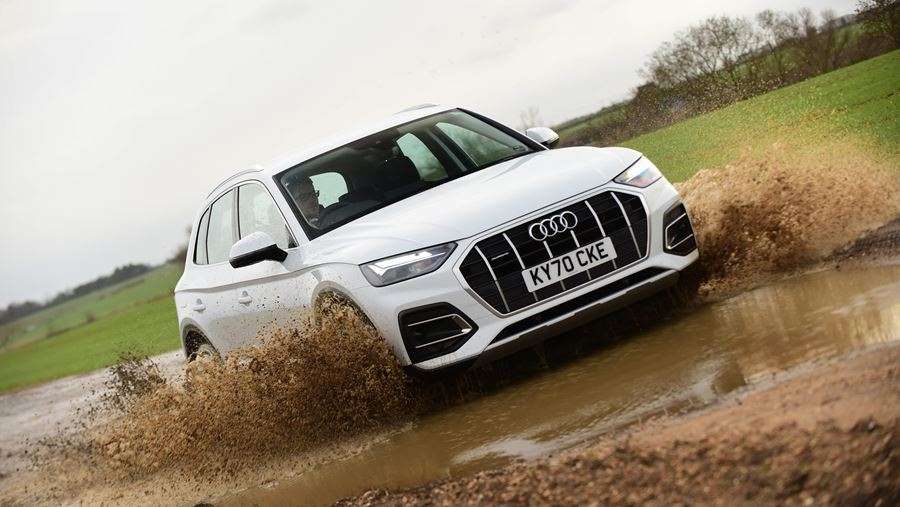
However, the mild-hybrid system has had a bigger impact on efficiency. The BSG charges a small lithium-ion battery when slowing down, which can be used to power ancillaries such as the climate control and electric power steering. In addition, the 2.0 TDI unit can cut out and coast at speeds of up to 99mph when you’re in the right driving mode, while the stop-start system activates below 13mph. It also makes things smoother when the engine does restart.
Claimed economy stands at 44.8mpg with 165g/km CO2 emissions, but while Audi is doing its best to make diesel less of a dirty word, it still feels like that in the current climate, the plug-in hybrid TFSI e will be a better bet for drivers seeking big efficiency and lower running costs.
Performance is strong, though, with some weight saving on engine components and the extra grunt delivering a 7.6-second 0-62mph time. In reality, nobody ever stretches their car’s performance to this degree all that regularly, but in conjunction with the seven-speed dual-clutch S tronic gearbox, the 400Nm of torque means it doesn’t kick down too many gears all that often when you want a more than moderate burst of acceleration.
Even if it does, the changes are pretty smooth – not whip-crack fast but well slurred to keep things relaxed – and the TDI unit’s sound is suppressed well enough that while it’s audible, it’s far from intrusive.
There’s little road noise too, helped by this car’s smaller wheels. They do look a little lost next to the big body, but they also improve the car’s ride quality.
The Q5 isn’t quite the most comfortable car in this class, but it rolls over ripples and imperfections in the road surface without too much fuss or transmitting a great level of shock or body movement, so it’s a smooth cruiser.
It isn’t the most dynamic option, though. The steering isn’t quite as direct as we’d like, even for an SUV (those big tyre sidewalls probably don’t help matters), while there’s some roll. But the Q5 is dynamically tidy enough to suffice; it’s comfort that matters more in a car like this, which it delivers, but the Audi is a bit dull when it comes to any sense of engagement.
Source: autoexpress.co.uk
Mercedes GLC SUV review
“The Mercedes GLC is an SUV that benefits from a lot of C-Class pedigree, but with a raised ride height and improved practicality”
Mercedes has had a car battling against the BMW X3 and Audi Q5 since 2009, but to UK buyers this may not have been obvious because the old GLK-Class was only sold in left-hand-drive markets. However, since 2015, the GLC, which replaced the GLK, has been sold here and is an SUV version of the popular Mercedes C-Class saloon on which it’s based.
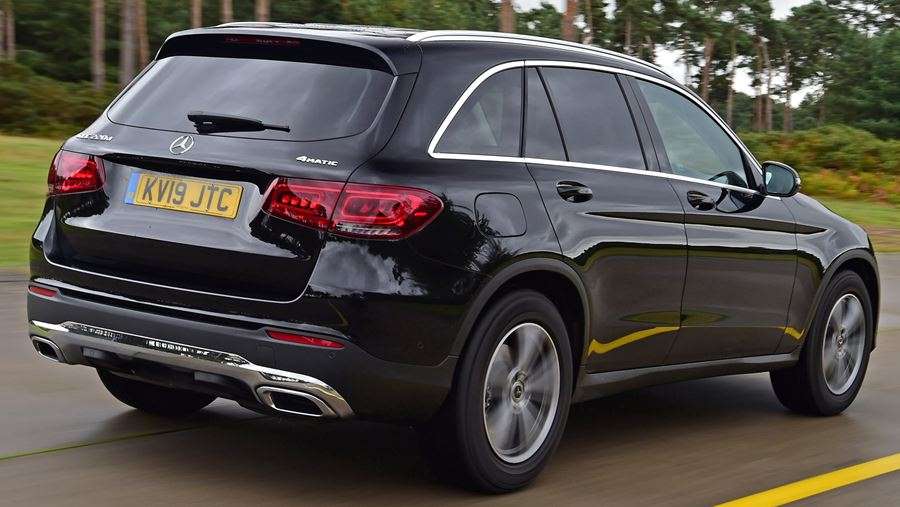
Mercedes gave the GLC a mild facelift in 2019, which involved some tweaks to the exterior design, some new engines and a plethora of technology upgrades inside. The updates were needed given how competitive the SUV market had become, and 2021 ushers in a plug-in hybrid version for the first time too.
Best 4x4s and SUVs
The revised GLC borrows engines and equipment from the C-Class. The similarities between the two models are harder to spot in style terms, however, unlike the Mercedes A-Class and GLA, which have more in common. The GLC is an attractive car in its own right, with the latest design including slimmer headlights and tail lights, and the latest Mercedes grille.
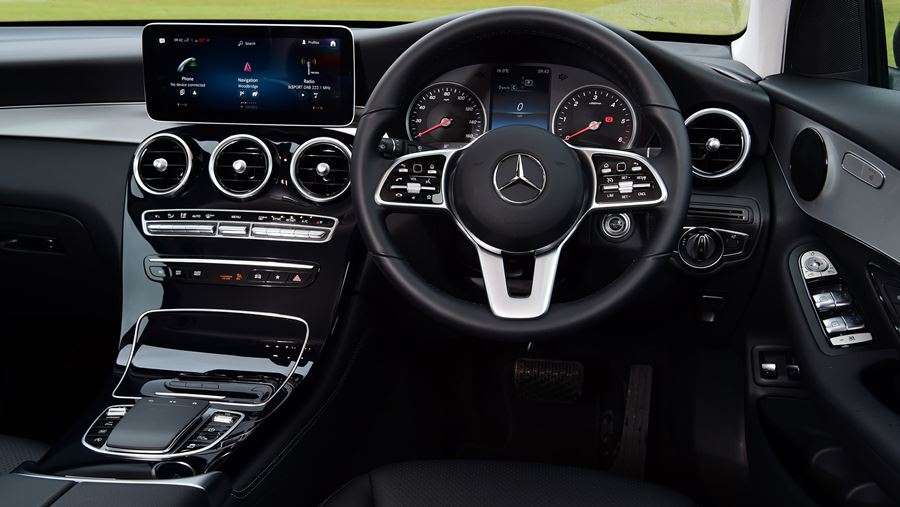
Every GLC comes with Mercedes' 4MATIC four-wheel drive and a smooth nine-speed automatic gearbox as standard. Versions badged 220 d and 300 d are fitted with the same 2.0-litre diesel, but tuned differently to produce 191 and 242bhp respectively. The 220d returns up to 45.6mpg and has CO2 emissions starting at 175g/km, while you can expect 42.8mpg and 184g/km from the 300 d, which are competitive figures. These are trumped by the GLC 300 e plug-in hybrid model, which can manage 26-31 miles of electric range and 122mpg. What’s more, its low CO2 emissions mean company-car tax is a third of the petrol and diesel engines.
A clear highlight of the GLC is its attractive and well built interior, which also has enough room for front and rear occupants to be comfortable, along with heater controls for people sitting in the back, which is surprisingly rare. There are lots of thoughtful cubbies and the 550-litre boot puts the GLC in the same territory as the X3 and Q5, while the Discovery Sport is more practical and has the option of seven seats.
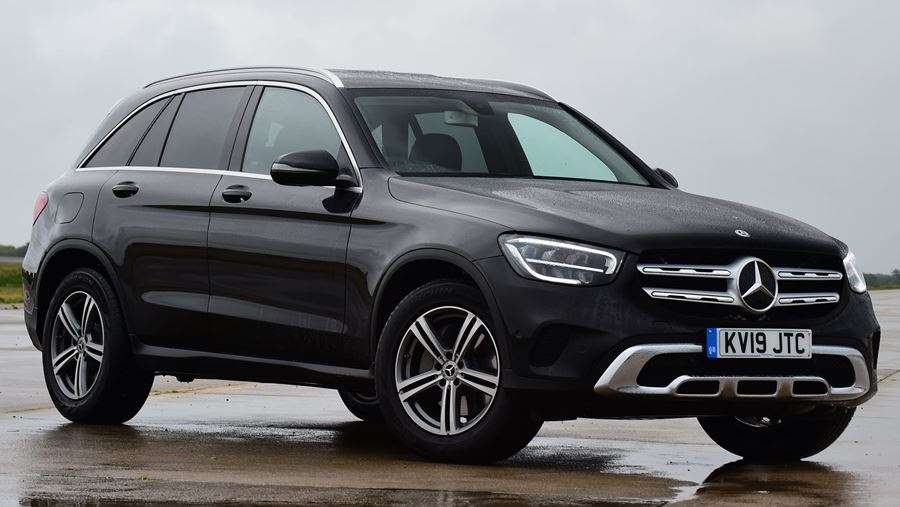
The introduced the latest Mercedes MBUX infotainment system, but unlike all-new models, there's still a tablet-style central screen perched on the dash, that looks slightly incongruous. The software is a major upgrade, though, and the main screen now responds to touch as well as the central control pad. A regular set of dials are standard, while a large 12.3-inch digital version is available as an option.
On the road, it soon becomes apparent that Mercedes concentrated on comfort when developing the GLC. It’s very smooth on the standard suspension and even more cosseting if the optional air-suspension is fitted. Drivers on the hunt for thrills may feel short-changed, though – while the Volvo XC60 is even softer, the newer BMW X3 is more responsive and poised on a country road.
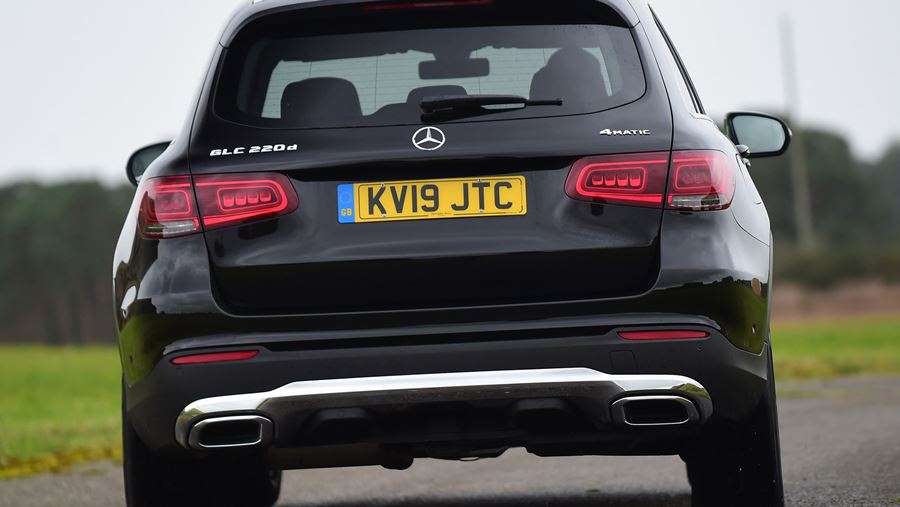
There are effectively three trim levels, consisting of the core AMG Line trim, plus Premium and Premium Plus versions. The 220 d engine is only available in AMG Line Premium and below; the more powerful 300 d is the AMG Line Premium and up. Desirable items like a powered tailgate, reversing camera and Artico leather upholstery are all included, along with sat nav and LED headlights. AMG Line Premium GLCs gain distinctive body styling and an interior makeover, as well as even bigger 20-inch alloy wheels.
AMG Line is now the most appealing trim for company-car drivers and we'd recommend spending the extra monthly finance cost for private buyers too, to benefit from all the GLC has to offer. The Premium equipment line includes adaptive headlights, running boards, a larger instrument display, ambient lighting, augmented reality navigation, Android Auto and Apple CarPlay compatibility and wireless smartphone charging.
Before it was facelifted, the GLC came 61st out of 100 models in our 2019 Driver Power customer satisfaction survey, but reliability wasn't a strong point, so owners will be hoping issues have been remedied. Further peace of mind should be provided by the GLC’s five-star Euro NCAP crash-test rating.
Mercedes GLC SUV - MPG, running costs & CO2
The Mercedes GLC is actually quite economical given its size
SPECIFICATIONS
The Mercedes GLC is pretty economical for an SUV, with its claimed figures rivalling the likes of the Audi Q5 and BMW X3. Mercedes also offers competitive warranty and servicing plans.
Mercedes GLC MPG & CO2
The 220 d version of the 2.0-litre diesel engine can return up to 45.6mpg, reducing slightly in top trims with optional wheels fitted. CO2 emissions of 175g/km mean it sits in the highest BiK band, which won’t appeal to company-car drivers. The more powerful GLC 300d is a shade less economical, at up to 42.8mpg, with emissions of 184g/km. By comparison, the BMW X3 xDrive 30d offers more pace and returns 46.3mpg with 159g/km.
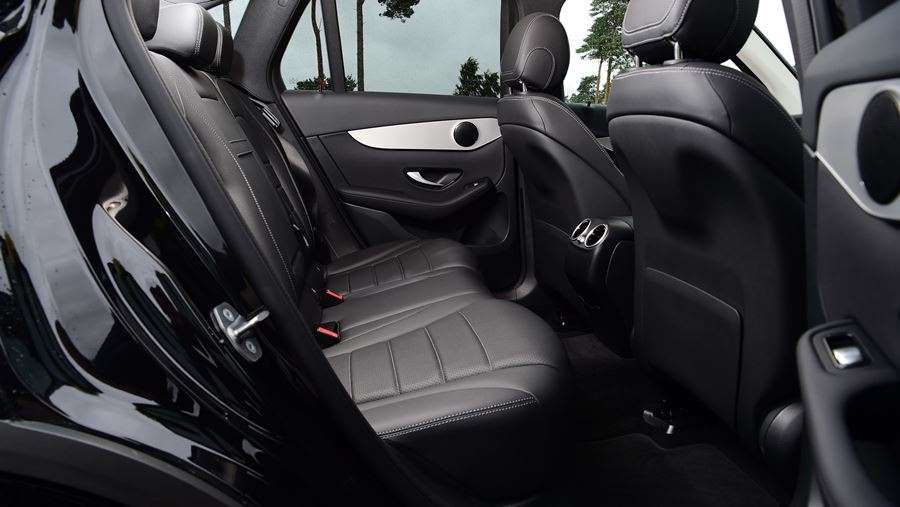
Petrol engines are offered too. A GLC 300 model promises up to 33.6mpg, while the AMG 43 and 63 models above are even thirstier. They certainly prioritise speed over running costs; you can expect 26 and 22mpg respectively. All petrols are in the top BiK band.
A plug-in hybrid GLC 300 de version is now available, pairing the 2.0-litre diesel engine with a 13.5kWh battery. It offers 27 miles of electric range and up to 156.9mpg if you regularly recharge the battery, while business users will be drawn to its 12-13% BiK rate. It’s also exempt from the London Congestion Charge until October 2021. In 2021 it was joined by the GLC 300 e, with a petrol 2.0-litre engine and an electric range of 26-31 miles. It can officially manage up to 128.4mpg with emissions of 62g/km and it takes around 2.5 hours to charge the battery using a 7kW home wallbox.
After the first year's CO2-based road tax (generally included in the on-the-road price), Mercedes GLCs cost £150 a year to tax, or £10 less if it's a hybrid. Every GLC now has a list price (including options) of more than £40,000, making it liable for an additional surcharge of £325 a year in years two to six, bringing the annual bill to £475 during that period.
Insurance
Insurance groups for the facelifted Mercedes GLC are quite high, with diesel versions starting in groups 32 and the GLC 300 de in groups 44-45 out of 50. Oddly, this is just as high as the AMG versions in groups 41-44.
Warranty
Mercedes provides a three-year/unlimited-mileage warranty on all of its new models, which is the same as BMW offers on the X3. Pan-European Mercedes Roadside Assistance is also included, that can last up to 30 years if you keep the car maintained within the dealership network.
Servicing
Mercedes offers fixed-price servicing plans that cover all scheduled maintenance. You can pay all in one go up front or spread the cost over monthly instalments, which should be about £35 for a diesel GLC.
Mercedes GLC SUV - Engines, drive & performance
Its diesel engines are smooth, but the Mercedes GLC is more of a comfortable cruiser than an exciting driver’s car

SPECIFICATIONS
Engine choice is reasonably limited in the Mercedes GLC, but the two diesel options are very smooth on the move. All also come with four-wheel drive as standard – a system Mercedes calls 4MATIC. The GLC is almost car-like to drive and as comfortable and sophisticated as a luxury limousine – a happy consequence of sharing a platform with the C-Class saloon.
The GLC is at its best when driven in a relaxed, unfussed manner than on spirited back-road jaunts. Although all models have clever dampers as standard, they seem optimised for soaking up bumps and improving ride comfort rather than providing sharper responses. For a truly rewarding SUV driving experience, the BMW X3 and Jaguar F-Pace remain the cars to beat, although in the comfort stakes, the Merc trumps the Alfa Romeo Stelvio. The Volvo XC60 is even more comfortable still.
Mercedes GLC SUV nose20
The GLC leans a little during hard cornering, but not so much as to feel unsettling and less than the Audi and Volvo. The steering is accurate enough, yet feels rather light and requires quite large inputs, so there’s little to encourage fast driving anyway. It’s far better to ease off the accelerator and cruise, which the Mercedes does very well.
All models use a smooth, responsive nine-speed automatic gearbox, which does a good job of keeping the engine revs low in the interest of fuel economy. The four-wheel-drive system is permanently engaged and uses traction control to ensure a firm grip on the road – any wheel found to be slipping is lightly braked and the engine's power is sent to the wheel on the opposite side to get you moving again.
Mercedes GLC diesel engines
Many people buying an SUV of this size will choose a diesel, and there are two available, badged 220 d and 300 d. Both are different versions of Mercedes' four-cylinder 2.0-litre engine, which is smoother and quieter than the 2.1-litre diesel it replaces, but still slightly more clattery than the best diesel engines found in rivals.
It might not appear like it if you look at the official performance claims, but most drivers will be satisfied with the slower 220 d, and it suits the GLC well. Mercedes claims 0-62mph times of 7.9 for the 200 d and 6.5 seconds for the 300 d, both of which will be more than fast enough for most SUV owners. That means our top pick is the cheaper 220 d, and it's a shame this isn't available with every trim level. Unlike the coarse old engine, the GLC 300 d we sampled was as smooth and quiet as a petrol, but with even more urge in real-world driving.
Petrol engines
Talking of petrol, the GLC 300 with 254bhp is available, featuring a new turbocharger, engine design and particulate filter all aimed at reducing emissions. It's also fitted with a mild-hybrid system that can recoup energy as the car slows down, then use it to aid acceleration. Acceleration from 0-62mph takes 6.2 seconds, while its top speed is 149mph. AMG models are even faster - the 43 model cracks 0-62mph in under five seconds, and the 63 and 63 S reduce this to four seconds or less. With the speed limiter removed, the GLC 63 S will carry on all the way to 174mph.
Hybrid engine
Most plug-in hybrids use a petrol engine, but the GLC 300 de has a diesel engine for long-range economy. The combination produces 302bhp, so the PHEV is quick too - 0-62mph takes 6.2 seconds. For 2021 the petrol-based GLC 300 e plug-in has also arrived, and it's even faster, taking just 5.7 seconds to get from 0-62mph.
Its 2.0-litre turbo petrol engine and electric motor produce a combined 316bhp, and it does a good job of prioritising electric power when the battery is charged. In this mode it's almost silent, and even when the petrol engine kicks in it's almost imperceptible. There's also a clever regenerative braking system that can be adjusted using the paddles behind the steering wheel or left to work automatically based on the road and traffic.
Mercedes GLC SUV - Interior & comfort
The Mercedes GLC has a well built interior and even the entry-level model has loads of standard kit
SPECIFICATIONS
The Mercedes GLC boasts an impressive, high-quality dashboard and interior design that’s more luxurious and up-to-date than what you’ll find in many rivals. All models are well equipped, but you’d expect them to be considering the GLC’s price. We'd recommend choosing an AMG Line Premium trim or above to really experience all the GLC has to offer.
Thanks to a honed suspension setup and using some parts from the Mercedes C-Class saloon, the GLC is very comfortable on the move whether on the standard steel springs of the Sport or the optional AIRMATIC system. Road and wind noise are minimal and a clever crosswind prevention system helps to keep the GLC stable at high speeds. Even the more sportily tuned AMG Line models maintain the comfortable ride of the Sport, although the wider tyres do kick up a little more noise from the road.
Mercedes GLC dashboard
The GLC shines when you sit behind the wheel. The entire design looks like it’s been lifted straight from the C-Class saloon, as there’s loads of solid metal switchgear and clear instruments. The middle of the dashboard is dominated by a single piece of wood or gloss-black veneer that starts from just underneath the infotainment screen and swoops down to connect to the centre console.
The classic air vents look like they’ve been taken straight from a vintage aircraft and the control for the sat nav and infotainment is the only control interruption on the centre console. The steering column-mounted gear selector is a little strange to get used to, though. It's also a shame that the standard analogue gauges and central trip computer look dated compared with the digital instruments fitted in AMG Line Premium trim.
Equipment
The GLC now comes in AMG Line trim as standard but extra kit can be added by upgrading to Premium and Premium Plus versions. Even the entry-level model has a comprehensive amount of equipment: a reversing camera, Parktronic, a powered tailgate, rain-sensing wipers, LED headlights, leather seats, automatic climate control, sat-nav and DAB radio are all standard.
The AMG Line Premium version throws in a sports bodykit and interior makeover, sports suspension, 20-inch AMG alloy wheels, adaptive headlights, ambient lighting and a 12.3-inch digital instrument display. Premium Plus is even more lavish, thanks to a panoramic sunroof, Burmester stereo system, keyless entry, 360-degree camera view and memory front seats and steering wheel.
Options
The Driving Assistance package is worth considering if you spend a lot of time behind the wheel, adding blind-spot monitoring, lane-keeping assistance, adaptive cruise control and a system that applies the brakes if it thinks you're about to hit the car in front. Air-suspension can also be fitted, further improving the ride quality. If you plan on towing, an official tow bar costs around £750.
Mercedes GLC SUV - Practicality & boot space
The Mercedes GLC provides loads of storage areas and its boot is a decent size, if not class-leading
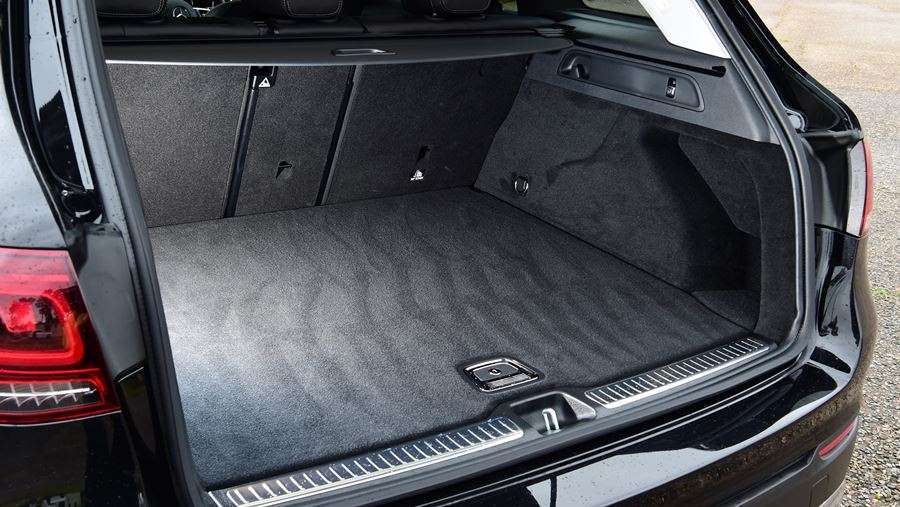
SPECIFICATIONS
Considering it’s an SUV, the GLC is easy enough to get into, as its doors open nice and wide. The steering wheel and driver’s seat have plenty of adjustment and there’s plenty of room in the back. Boot space is good, if not class-leading, but the plug-in hybrid offers noticeably less due to its batteries taking up some of the luggage room.
Mercedes GLC interior space & storage
The GLC offers a decent amount of leg and headroom in the rear, but the transmission tunnel can eat into space for the middle-seat passenger.
Interior storage is good, thanks to a generous space in the front armrest and a deep cubby in front of the infotainment dial in the centre console. The door bins can all hold bottles and rear-seat occupants get their own air ventilation and an armrest that features a storage cubby and two cup-holders.
Boot space
Total boot volume is about on par with a lot of the GLC’s rivals. The 550 litres on offer is the same as what you get in the BMW X3 and equal to the Audi Q5’s boot. However, it’s less than what’s available when you fold down the Land Rover Discovery Sport’s third row of seats. The GLC’s rear seats fold in a 40:20:40 configuration with the pull of a lever, offering extra versatility and more room in the boot if needed.
In the boot you’ll find the usual range of neat practical touches like anchor points for smaller items and a cubby either side to store bits and bobs. The boot itself is square and the opening is large, so getting awkwardly shaped items in should be a breeze, especially with the power-operated tailgate.
Compared to the 550 litres you get in petrol and diesel cars, the PHEV’s boot is a bit smaller at 395 litres. That’s only 25 litres more than in the A-Class hatchback but at least the boot floor is flat, unlike the annoying step in the boot of the E-Class plug-in. It also benefits from underfloor storage, so you can keep your charging cables separate from your shopping.
Towing
All diesel GLC models can tow 2,500kg – more than most versions of the Land Rover Discovery Sport, and matching the D240. Both the GLC 300 de and 300 e can also tow up to 2,000kg, which is an impressive amount for a plug-in hybrid.
Source: carbuyer.co.uk
The Chevrolet Camaro is recording declining sales results
Probably the most popular American "muscular" car is the Chevrolet Camaro, and this year it recorded very poor results.
According to B92, only 29,775 copies of the Camar were sold, which is 38.9 percent less than a year earlier. Certainly, the coronavirus pandemic has affected sales results, but it seems that interest in this model is declining.
For example, the Challenger model had a good year and 52,955 units were sold.
Ford has not yet been announced in the vicinity of the sale of the Mustang, but it is believed that there are about 60,000 copies, since 47,637 copies of that car were sold in October.
2021 Nissan Kicks First Drive Review: Actually Kicking It Up a Notch
Small but welcome updates keep the nearly new Kicks SUV fresh and competitive.
If I'm entirely honest, the Nissan Kicks didn't have the makings of a hit when it was first announced for the U.S. market. Adapted from elsewhere in the world and a bit behind Nissan's own styling curve, it appeared to be a quick and dirty move to get something, anything in a suddenly hot segment. Driving it, though, revealed its charm. What it lacked in specs it made up in value and practicality. It surprised with a carefully chosen but impressive list of standard features and a genuinely enjoyable driving experience. Even so, Nissan has kept on top of updates, culminating in this smartly refreshed 2021 Nissan Kicks.
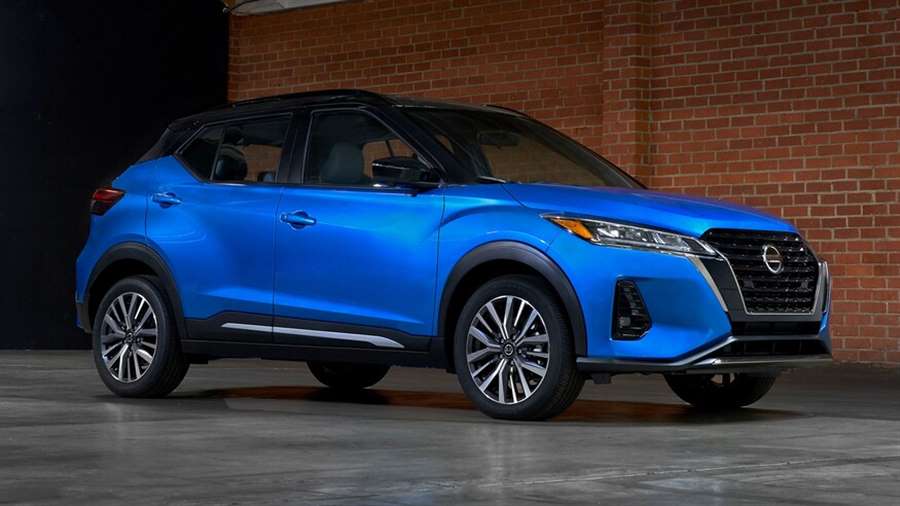
The biggest fix is right up front, where Nissan has given it a nose job. Although the Kicks has always had a fun, funky vibe going on, the old car's puckered face always made it look like it had already been on Nissan lots for years. Pumping up the grille and upgrading the headlights (all the way up to full LED units on the SR trim we drove) have gone a long way toward making the Kicks look like a new car rather than a retread. The rear end didn't need as much help but got it anyway for a net gain.
The most important work, though, was done inside. It sounds like a small thing, but a new center console is worth talking about here. Few things remind you of how cheap a car is as not having a center armrest for the front passengers. Nissan has fixed that with a full-length center console featuring an enclosed bin for your things, an armrest, and big cupholders. Deleting the old-fashioned handbrake made it all possible, and you get a modern electric parking brake as a bonus. Unfortunately, you do have to pay for it because you can only get it on the SV and SR trims. The base Kicks S keeps the old setup.
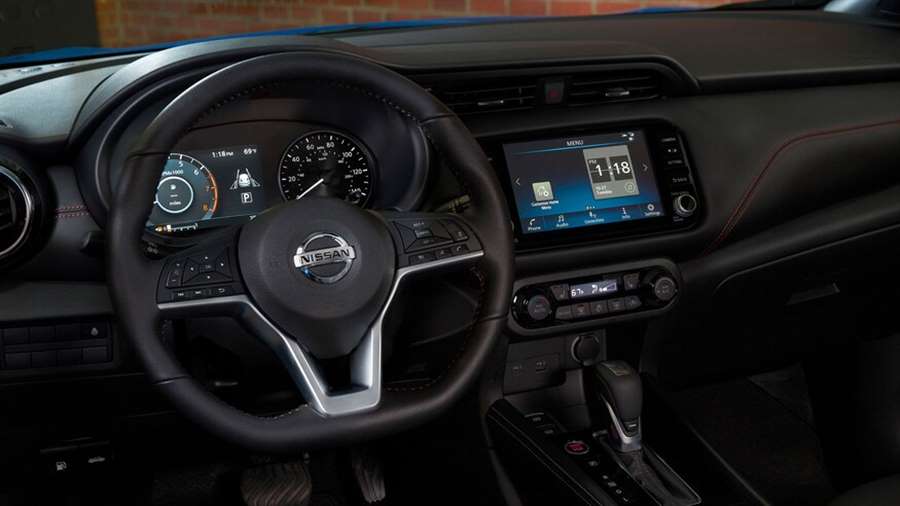
Hovering above all that is an updated infotainment system. Seven inches is standard, but it now provides Apple CarPlay and Android Auto functionality free of charge. The optional upgrade unit grows to 8.0 inches and now includes a Wi-Fi hot spot and over-the-air software update capability.
You have to look a little harder for the other big get. The Kicks has always had the hardware needed for adaptive cruise control but didn't offer the feature until now. Add it to the shockingly long list of active and passive electronic driver aids, which already got a big upgrade for the 2020 model year and most of which is standard on all models.
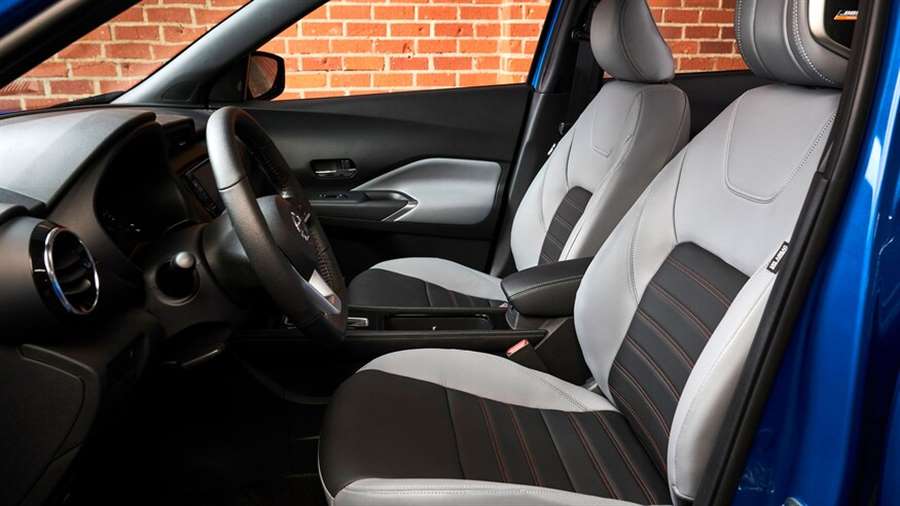
The new splashes of accent colors on the seats and doors are more visible. It's a small thing, but on a car with fun two-tone paint options, the black-on-black interior needed more pizazz, and it didn't take much to dress things up. The Kicks already felt like a screaming deal at $25,000 fully loaded (before dress-up accessories), and the '21 updates only make it feel like you're getting more for your money.
That feeling doesn't extend to the mechanical bits, but they were already doing a fine job. With only 122 horsepower and 114 lb-ft of torque and no substantial weight added, the Kicks drives exactly the same as it always has. Here again, there's nothing special on the spec chart, but Nissan does a lot with a little. Its simple suspension works quite well at providing a comfortable ride and chipper handling. It still has a bit of body roll, and the steering still feels disconnected, but somehow it's fun to swing around a corner when you get the chance.
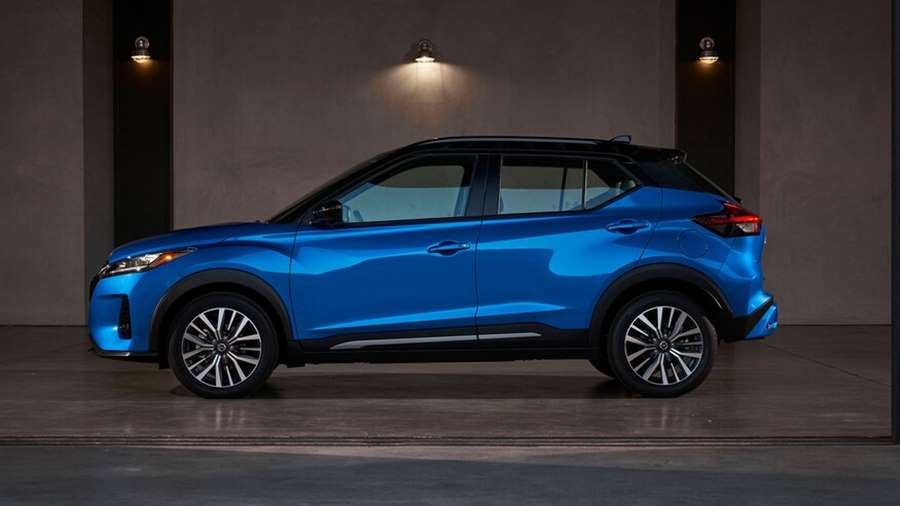
Similarly, the continuously variable transmission is tuned well to make it feel like the little engine is really trying. It's still among the slowest new cars on the road— it needs more than 10 seconds to get up to 60 mph—but its eager demeanor makes it feel quicker than it is. Meanwhile, it continues to get excellent fuel economy at 36 mpg on the highway.
It can get noisy getting up to speed and then cruising on the freeway, so I again have to recommend the SR Premium package if you can swing it. The Bose Personal Plus stereo included in the package delivers better sound quality than some luxury cars I've driven. It's an easy recommendation when the whole package, which gets you nice faux-leather seats, a security system, a cargo cover, and heated steering wheel and front seats, only rang in at $1,000 last year. Now, though, it includes the NissanConnect services, a WiFi hotspot, and over-the-air software update capability, so don't be surprised if the package price goes up.
Although Nissan hasn't released complete pricing yet, we do know the starting price has gone up by $430 to $20,595. That's still an incredible deal, though it's worth remembering the base model didn't get any upgrades. We're still waiting to find out how Nissan will price the SV and SR models with the new goodies. Even if those prices do go up a bit, the Kicks will likely top out in the neighborhood of $27,000, and that still could be a killer deal, especially now that there's even more to back it up.
I've always maintained the Nissan Kicks' greatest quality is its honesty. It's an inexpensive car that doesn't try to trick you into thinking it's something it's not. The good features aren't all reserved exclusively for the top trims or buried in dozens of add-on packages. Everything is straightforward and a solid value. It's a car that knows what features you actually want and delivers them with unpretentious style.
Source: motortrend.com
A NEW HONDA S2000 COMING IN 2024!?
Reports have said the Honda Roadster could be reborn
It's been 11 years since Honda's record breaking roadster went out of production. This has left the Mazda MX-5 in a league of its own being an entry level sports car, with open air thrills. After years of asking for at least a successor, it seems Honda has responded.
According to a Forbes report, a source "close to Honda" told them that Honda's marketing team members are, "seriously considering", bringing the S2000 out of retirement in 2024. That launch year would mark the 25th anniversary of Honda's beloved roadster, which would be very good timing.
The Forbes report also states that it's proportions are rumored to be similar to that of the original S2000, but be lighter by using aluminum and carbon fibre with a rumored weight below 3000lbs (1360kg). It will also supposedly be more powerful too but instead of using a high revving naturally aspirated I4, it will supposedly use a tweaked version of the current Civic Type-R's 2.0L turbocharged I4 which is currently pushing 320hp and 295 lb-ft of torque. Honda is reportedly looking at pushing that power figure up to 350hp for the S2000. Sure it might not scream all the way to 9000rpm anymore which is always glorious to hear, more power and forced induction is never a bad thing.
If all of these things are true, it will probably blow out any competition that it would have. It would no longer be an entry level sports car like the MX-5 or BRZ/GR86. The power figure and probable price for a new version of the car would put it in competition with the GR Supra or even the new Nissan Z which will be out by that point especially if Nissan decides to make a convertible version of it.
Keep in mind that this is all rumors at this point and to take with a grain of salt but let me know what you think of this in the comments. Don't forget to give this article a bump and don't forget to follow me for more content like this.
Source:drivetribe.com

